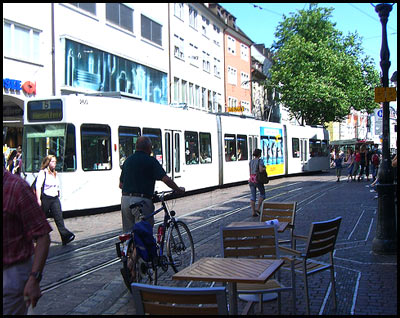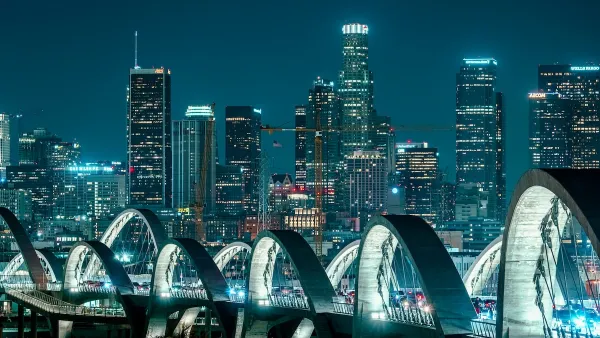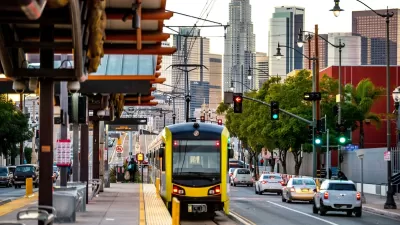A new design competition is seeking solutions to L.A.'s transportation problems. But the real solution may not have anything to do with transportation at all.
Sometimes it's good to be a city. If there's a problem, and that problem is really bad, and it won't go away, somebody at some point will buckle and go beyond the traditional procedure to try to do something about it -- or at least get somebody else to do it. This is the amazing model of the design competition. People pay to enter, other people pay to award the winner, and the city pays little or nothing. It just sits on the receiving end of an intelligent and detailed solution to its problem.
It's a good thing this model exists, because there is a city with one major problem and very little cash available for solving it. Right on time is "A New Infrastructure: Innovative Transit Solutions for Los Angeles", an open ideas competition sponsored by the Southern California Institute for Future Initiatives (SCIFI) at the Southern California Institute of Architecture and The Architect's Newspaper. The competition calls for new ideas to make L.A. County's transportation infrastructure better. It's a great premise for a competition because getting around L.A. is horrible. And there is no shortage of ideas on what to do about it.

Transportation is a subject that comes up a lot around here, especially in formal discussions about the city. I've been to a lot of talks and lectures focused on cities or L.A. over the last few months, and invariably the topic of mobility comes up -- whether it's on the agenda or not.
There's always that point at the end of these types of discussions, especially in L.A., when the audience's questions drift towards how planners or architects or designers or politicians can make it easier to get around. I guess this makes sense: transportation issues are what people typically experience most often in this city, making it probably the most approachable planning topic for non-planner types. And the conversation is almost always the same. They all want to know how to get from point A to point B faster, more efficiently, and with less traffic. The likely solution, it seems, is to reduce congestion and increase transit; achieving these two fronts will make the city better. Or at least that's the assumption.
But really, it's the other way around: make the city better, and as a result transit use will increase and congestion won't even be a problem. Not that congestion won't be there, as it certainly will, but it will be less of an issue because people will experience it less. Essentially, L.A.'s traffic problems (and those of any other city) are experiential – traffic is only a problem when you're stuck in it. This might seem selfish, but traffic is, at its core, a selfish issue. People don't complain about traffic because everyone is stuck in traffic. They complain because they are stuck, and it's making them late or making their ride much longer than their patience.
Improving transportation in L.A. is really a matter of reducing the need to be in a car. Or even a bus, for that matter. If it were easier to do all the things people need to do within a closer proximity, people wouldn't have to go across town and back over and over again.
But let's be clear: L.A. will always be a driving city.
It's unfortunate, but it's true. There's always going to be millions of people driving in, around and through L.A. As a vibrant city in a geographically dispersed metropolis, L.A. will consistently draw people -- for jobs, tourism and lifestyle reasons, but due to its polycentric destination-based layout, the car will remain the most reliable way to travel long distances between many places. And it's likely to be the dominant transportation mode for the city as a whole for a long time. But for individuals, it doesn't have to be. L.A. is (despite common perception) a very dense city. But it's a density that's incredibly compartmentalized. Each land use has its place, and the places where these uses mix effectively are far too few. What the city needs is a better mix that's better distributed.
If it were possible in every neighborhood in the city to walk 20 minutes and pass a grocery store, a child care facility, a restaurant, a park, a bar, and a transit hub, the whole city would be walking -- or at least not driving as much. A 1996 report on National Personal Transportation Survey data found that doubling density brought down VMT by 38%. I know driving is deeply ingrained in the American identity, but as costs rise, parking gets worse and congestion sees only slight reductions, walking will start to seem like the smart thing to do. But to get people walking, neighborhoods need places people can walk to: goods, services, and amenities.
I'll be curious to see what types of proposals are submitted for the L.A. transportation infrastructure design competition. I'll be even more curious to see which proposal is chosen to solve the problem when the winner is announced on March 21. No doubt there will be some incredibly interesting transit systems and corridors proposed. But as competition entrants, planners and the public in general try to develop ideas about how to make better transportation infrastructure, we really should be thinking more about how to make the city a better place to hold it.
Nate Berg is assistant editor of Planetizen.

Maui's Vacation Rental Debate Turns Ugly
Verbal attacks, misinformation campaigns and fistfights plague a high-stakes debate to convert thousands of vacation rentals into long-term housing.

Planetizen Federal Action Tracker
A weekly monitor of how Trump’s orders and actions are impacting planners and planning in America.

Chicago’s Ghost Rails
Just beneath the surface of the modern city lie the remnants of its expansive early 20th-century streetcar system.

Bend, Oregon Zoning Reforms Prioritize Small-Scale Housing
The city altered its zoning code to allow multi-family housing and eliminated parking mandates citywide.

Amtrak Cutting Jobs, Funding to High-Speed Rail
The agency plans to cut 10 percent of its workforce and has confirmed it will not fund new high-speed rail projects.

LA Denies Basic Services to Unhoused Residents
The city has repeatedly failed to respond to requests for trash pickup at encampment sites, and eliminated a program that provided mobile showers and toilets.
Urban Design for Planners 1: Software Tools
This six-course series explores essential urban design concepts using open source software and equips planners with the tools they need to participate fully in the urban design process.
Planning for Universal Design
Learn the tools for implementing Universal Design in planning regulations.
planning NEXT
Appalachian Highlands Housing Partners
Mpact (founded as Rail~Volution)
City of Camden Redevelopment Agency
City of Astoria
City of Portland
City of Laramie





























